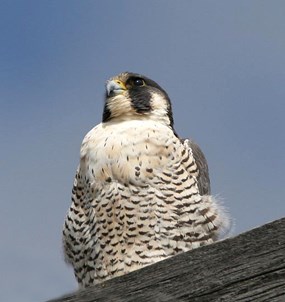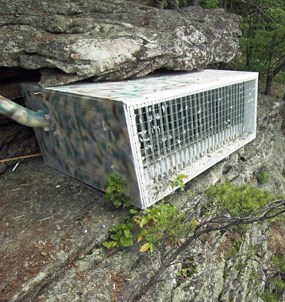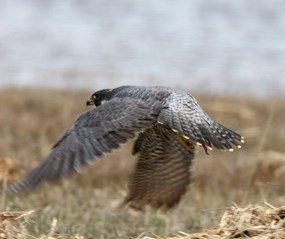|
Dinosaur's canyon country has special appeal for hikers, river rafters, and peregrine falcons. The first two may savor the stunning scenery, solitude, or adventure, but for the peregrine falcon the canyon country is the perfect home. Diverse plant communities support an abundant prey base and the sheer, secluded cliffs of the Green and Yampa rivers are ideal eyrie, or nest, sites. With these peregrine-perfect canyon cliffs, Dinosaur NM played a critical role in the recovery of the endangered peregrine falcon in Colorado. 
NPS 
USFS Decline of the Peregrine Falcon Peregrine Foster Parents Eggs collected at Dinosaur NM were taken to breeding facilities where researchers incubated them and cared for the young after they hatched. Although fostering did not eliminate normal chick mortality, it did help to maintain normal brood sizes during the period of eggshell thinning. 
NPA Hacking at Dinosaur NM Hacking takes place over several weeks. Initially, young peregrines are placed in specially equipped boxes on a cliff ledge and, to minimize their exposure to humans, are fed through a chute. When the birds are old enough and strong enough, the box is opened. As the young peregrines learn to hunt, the human-provided food is reduced. Eventually, the peregrine falcons become fully independent. At Dinosaur NM, hack sites were operated at Deerlodge Park in the early 1980s and Split Mountain in the later part of the decade. A hack site was also established in Harding Hole, but never used. 
USFS
Although the canyon country of Dinosaur NM continues to sustain the hiker, the river rafter, and the peregrine falcon, the falcons' success story extends well beyond Dinosaur NM. Programs similar to the one at Dinosaur have helped peregrine populations recover across the country: according to the U.S. Fish and Wildlife Service, there were 324 known nesting pairs in 1975 and today there are between 2,000 and 3,000 pairs of peregrine falcons in North America. Thanks to these recovery programs, the peregrine falcon was removed from the list of endangered species in 1999. 
USFS |
Last updated: January 22, 2021
